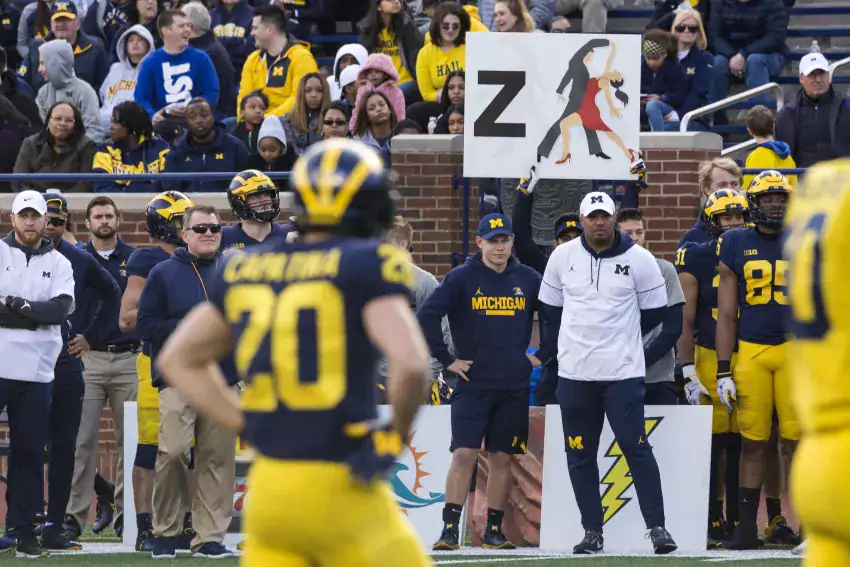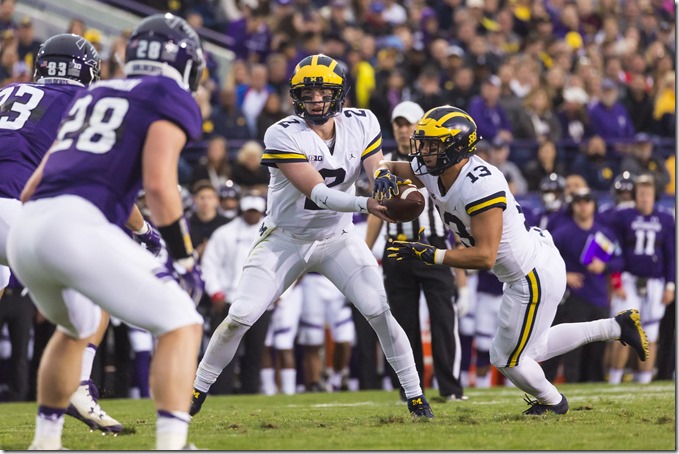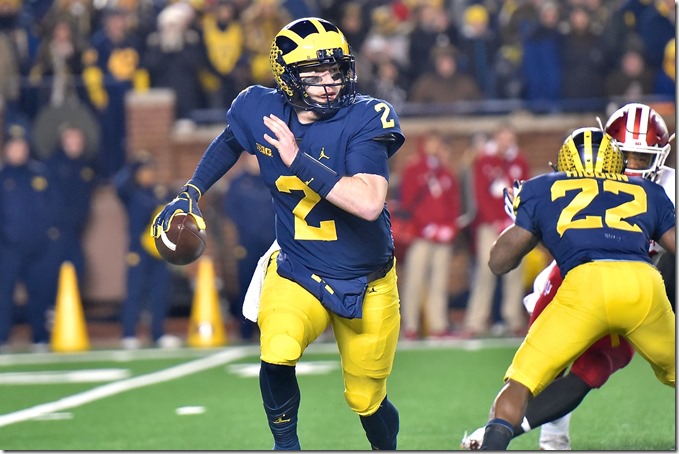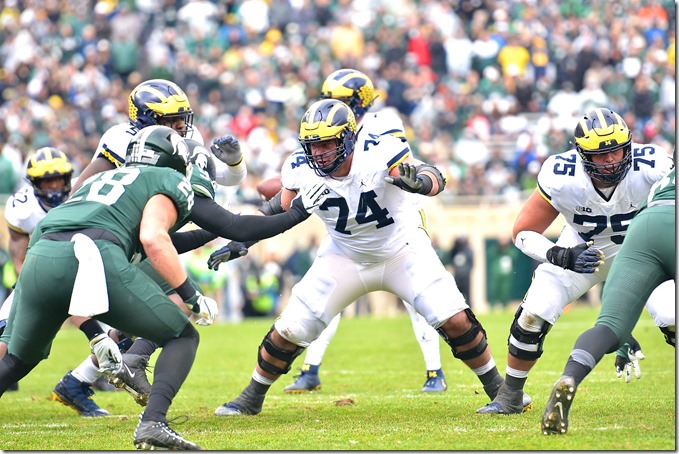
Preview 2019: Five Questions, Five Answers, Offense

Previously: Podcast 11.0A, Podcast 11.0B, Podcast 11.0C. The Story. Quarterback. Running Back. Wide Receiver. Tight End. Offensive Tackle. Interior OL. Defensive End. Defensive Tackle. Linebacker. Cornerback. Safety. Special Teams.
1. So what is this offense going to look like?
make eyes useful [Patrick Barron]
A large chunk of it is going to be bog-standard spread offense. Even if Michigan was keeping things under wraps during the spring game, they weren't running plays they don't expect to have in the offense this fall. And a lot of those plays were just dropback passes or conventional-looking zone reads.
Michigan did mix in a number of plays that hinted at an evolution of last year's arc read system and a new frontier in misdirection and wide plays. I thought this four-play series culminating in the McCaffrey rushing touchdown was enlightening:
The camera work left a lot to be desired, so here's the high-level view:
- Two TEs with Eubanks off the line of scrimmage; Eubanks pulls across the formation for split zone. This is part of the arc package; I remember getting frustrated with McKeon in the MSU game for not executing this. VanSumeren rips off a chunk run.
- Twin TE pistol set on which Michigan tries to run a stretch and gets swamped. RPS loss for O.
- 2 TEs still but Michigan motions the TEs out for a four-wide look and runs speed option to the field.
- Twin TEs again. Speed option or a flare is threatened one way, drawing the linebackers; after a beat McCaffrey runs a QB pin and pull the other way for a touchdown.
[After THE JUMP: lots of Gattis stuff.]
These four plays tell us a lot about what Michigan's going to try to do on the ground:
- Reads. Two of these plays are genuine post-snap reads, and many more were sprinkled throughout.
- Edges. Michigan threatens the edge on all these plays. The split zone that kicks it off freezes the playside DE because McCaffrey is a threat to keep and the arc is a threat to have that keep go a long way. A stretch naturally tests your edge. Then a speed option and the capper: threatening one edge and attacking the other one.
- Tight ends. Gattis has the offense but he's not sticking his fingers in his ears and shouting "na na na." Warinner and Harbaugh have their influence and you can see it in this package. Michigan's 2TE packages gave them an absolute ton of stuff they could do with arc games last year—more even than you may remember, because there were a number of plays that were there tactically but weren't executed because of a lack of familiarity. It looks like Michigan is building on last year's arc game.
Michigan is going to use their slots. But if Eubanks can block this year he's going to get snaps. That tight end stuff popped up pretty frequently in UFR. Penn State:
Michigan seemed to anticipate that PSU would try to stymie the arc games with exchanges, so instead of running the tight end to the backside like it's split zone they lined up two TEs to the arc side and let the DE free anyway. PSU seemed baffled by this. First the DE wasn't ready to be unblocked:
PSU DE #99 to top
He's static, standing around, and Patterson gives.
The next time he tore at the RB, which he'd do most of the rest of the day. But without the split zone motion from the TE it didn't seem like the PSU defense was prepared to defend the arc. Patterson's first carry of the day sees him get a dead easy read as the DE crashes hard, and then nobody replaces him. McKeon can go to the safety and if he does a better job getting a block here this is a walk-in TD:
They'd get that later on the second keeper … Eight runs, seven points, ballgame. Pretty much.
By the end of last year I'd gone from WHO ARE WE READING WE ARE READING NOBODY…
Okay, how about the return of a bad old Hoke thing: read option nobody. Who is being read here?
Nobody.
This isn't an RPO. It isn't a play where the QB is a legitimate run threat who holds an unblocked DE. It's just a spread play where you're at a numbers disadvantage.
…to calling Michigan's arc approach "legitimately innovative" since I've rarely seen a spread option attack use two tight ends. Michigan can marry a modern approach to some vestiges of manball and get an offense that people don't see week-in, week-out as they do with standard 3 WR, 1 TE packages.
So they're going to keep that. They're going to have most of the stuff they ran last year at their beck and call since Warinner's still around. Then on top of that you'll have a chunk of the offense that's new, option-based, attacks the edge, and often both edges at the same time.
2. Uh that was all about the ground. Throwing stuff?
on the move [Bryan Fuller]
To some extent, dropback passing is dropback passing. I'd imagine there's less of that overall and Michigan gets more clear wins against zone by running more college zone beaters like flood; Hamilton's route patterns always seemed to expect an NFL QB or college Andrew Luck—viable against anything if you are an elite throwing robot, but not liable to give you obvious decisions. After Penn State I asserted in UFR that Michigan was "even getting some RPS wins in the passing game, which have been a rarity this year."
Gattis has repeatedly asserted that Michigan is going to make people defend every eligible receiver on every play, and exploit every inch of grass that the defense has to deal with. This was not the case last year. Wisconsin:
There were a ton of plays on which Patterson had two guys in a route, or even just one. The failed fade to Collins is an RPS loss. UW drops a linebacker into the slant and the CB can play fade the whole way. Collins has zero chance of winning this route:
But hey you got two for one there and they're only rushing three, right? Go find someone else. There is no one else. Look at the quad WRs. They are not in routes. Michigan put all their chips in on the fade that was the obvious riposte after an early slant.
There was a giant gap between what Michigan was doing in the ground game and the stuff they were doing in the pass game. Remember "Good shit, Jedd?" Yeah. That was gone.
Speaking of obvious decisions: Michigan is going to be much, much better about connecting their passing game to their run game, and using their other routes to get clear RPS wins. Michigan didn't get many RPS positives on passing downs last year, and the shape of them is informative. Routes hit on RPS positives from the MSU game: flare, TE drag, screen, slant, angle, and a fade. (That fade was the 79-yard TD that got an RPS plus because MSU tried to man up DPJ with no safety help; sometimes RPS positives are more about the opponent derping.) Against Wisconsin: quick out, hitch, hitch, TE deep out, drag.
Deep shots were mano-a-mano stuff and did not attempt to break a safety's brain. At no point did Michigan pop out of their very successful arc looks to hit a receiver downfield. Michigan did have some route combos that popped guys open with rubs; they had some waggles that worked out. Waggles have always been the Atari 2600 of play action, though. They're necessary, boring, and if that's the culmination of your passing attempts when you've fooled the defense you're getting scattered 8-yards plays out of it and nothing else.
Gattis's background has crazy production from guys operating out of the slot. PFF just took a look at Gattis in a post that's half interesting and half dubious. The interesting bit:
Nittany Lion pass-catchers who lined up in the slot recorded a cumulative 78.0 receiving grade (fifth in FBS) in 2017. They compiled an incredibly efficient 16 touchdowns (fourth), 45 explosive plays of 15-plus yards (seventh), 72 first downs (12th) and 20 contested catches (second) on a middling 153 slot targets (42nd) and 33% slot target rate (65th). …
Of course, Alabama pass-catchers lined up in the slot also led the nation with a cumulative 93.2 receiving grade. They had astounding production, with 2,354 receiving yards (second), 23 TDs (third), 92 first downs (sixth), 54 explosive plays (second), 4.98 yards per route run (first) and a 139.1 passer rating when targeted (second) on 182 slot targets (19th). In fact, Gattis boosted Alabama’s slot target rate from 28% in 2017 to 41% in 2018.
Much of the time the guys operating out of the slot are outside receivers like Chris Godwin moonlighting. These are offenses that put safeties in conflict and hit the guys safeties usually pick up—slots—for explosive plays.
Part and parcel of that are RPOs. The most dubious part of that post:
Last season, Michigan ran just 129 RPOs (89th most in FBS) with 93 runs and 32 passes. Despite a predictable 3:1 run rate, Michigan racked up a sizeable 7.3 rushing yards per attempt (third in FBS).
I may have missed some, but if Michigan ran more than 20 real RPOs on the year I'll eat my hat. Also, if your RPOs have a predictable run bias they're not RPOs. I think I might have noticed 129 RPOs since every time Michigan actually ran one I was like "ooh, shiny!" I had a specific RPO category for protection that got used maybe 10 times in the first 11 games. And they're not hard to ID: run blocking, one WR running a route in the QB's POV.
Anyway, I'm crabbing about this because Michigan's refusal to RPO for much of the year made them susceptible to blitzball linebackers. This was never more of an issue than against Northwestern, which always seems to have a tell as to whether Michigan will run or pass. The RPO kills those tells dead and turns this maniacal TFL into a 30-yard chunk:
use the power of your mind to convert TE #83's futile attempt to block into a skinny post
And when Michigan actually ran RPOs they were crazy good! Michigan had one incompletion against Indiana and everything else was good. Patterson was able to make the decision and come up firing:
[Side note: here's another spot where 2TEs is productive. McKeon can get as far downfield as he wants because he's eligible, and that helps draw the second level in.]
This is Patterson's wheelhouse, and has always been his wheelhouse, and the paucity of RPOs last year was about 0.4 Denard Under Centers. I thought this 24/7 article on Patterson as a new version of quarterback analogous to a shortstop was really good:
“It’s kind of interesting to look back at Shea’s recruitment,” said Barton Simmons, 247Sports director of scouting. “You had him and Jacob Eason, with Eason very much being the tall, strong-armed, stand-and-throw guy that is usually so coveted. ... Shea had much more of a baseball delivery. He was an athlete behind the center.”
Baseball delivery might be the best phrase for it—in many ways, the modern spread quarterback is less Byron Leftwich and more middle-infielder*. Catch the ball out of the shotgun, get the ball out quickly; not altogether different from a shortstop trying to turn a double play. Quick hands. Quick feet. Quicker decisions. …
“He was intensely competitive—that was really, I think the thing that set Shea Patterson apart,” Simmons said. “He also came out at a time when we were starting to look at the quarterback position differently. He was a great representation of positional evolution, since he was mobile, athletic, had a really clean, quick delivery and he could operate off-platform or change arm angles. It’s everything today’s quarterback is asked to do.”
Patterson's going to be putting the ball in a mesh point, getting it quickly up to a throwing spot, and releasing in rhythm. He's going to be off-platform a lot, fitting things in between defenders a lot, and moving a lot. All of this is stuff he's excellent at.
Michigan's passing offense will be better tactically, easier for Patterson to execute, and aimed squarely at safeties trying to decide whether the running back or Donovan Peoples-Jones is his assignment.
3. Is there any pass protection upside?
get greedy [Bryan Fuller]
In year one under Warinner Michigan's pass protection improved radically from close to national-worst to meh. Now all the low-hanging fruit—having just one system, ever picking up a stunt, having a center who points at things—is in the rear view mirror. And things still got hairy late in the year.
A lot depends on Jalen Mayfield living up to the hype. If he does he'll be a massive upgrade on Juwann Bushell-Beatty. If he lives up to half of it he'll be a massive upgrade on Juwann Bushell-Beatty. Michigan spent much of the year supporting JBB with tight end and running back chips, and eventually they just went with Andrew Stueber. If Mayfield can subsist by himself, Michigan can move the help to Jon Runyan Jr, and then maybe you can see a top 20 pass protection number.
The nature of the offense is going to help as well: RPOs don't require any pass blocking, and if non-RPO play action does get incorporated correctly that will also help slow down opposing rushers.
Michigan playing a (very good) guard at tackle is going to put a cap on how good they can get, but there's upside yet in the pass protection numbers.
4. Are we worried about transition costs?
It's always a concern when you're installing a bunch of new stuff. Michigan supplied plenty of evidence of that midseason when they were moving to their arc package. There are going to be some hiccups.
I think they'll be overwhelmed by the good bits, particularly because Michigan gradually drifted towards more of a Gattis approach as the season went along. They even toyed with a very Gattis play:
…the very next play sees Michigan do the same downblock/double playside pull while Bredeson pulls the other way(!).
#74 LG
This naturally confuses the linebacker level but Michigan can't quite give Higdon the frontside gap that would take advantage of that. Meanwhile I'm watching the backside of that play and converting McKeon's attempted safety block to a crack on Connelly and zipping Patterson through that gap. I called this Unicorn Salad, because I'm out of real names for plays and "frontside pin and pull, I guess, with a counter-flow backside pull and possible keep option?" doesn't fit in the chart.
They returned to that once or twice later but never paid off the two-way action. Gattis absolutely will. I bet a dollar Unicorn Salad sticks around this year.
They also added more RPOs—although never enough—as the season went along. Patterson was excellent reading them and getting the ball out in a flash since that's what he spent the bulk of his career doing until he moved to Michigan. Harbaugh cited Patterson's comfort level as a reason to move to an out-and-out spread:
"This year the offense will look different," Harbaugh said. "The major ways it will look different will be shotgun, no huddle. Shea (Patterson) is good at that. He operates really well with that and he can run. He can use his legs. He’s got quick decision making that really fits the RPO world."
There's an argument that Michigan is moving away from transition costs imposed by last year's offense. Patterson is a better fit.
The main way transition becomes an issue is if the offensive line can't execute outside zone. Michigan ran it a little bit last year, but there's a big difference between running something as a base play and running at as curveball. If Gattis wants to run a lot of it and Michigan isn't that good at it, that could be an ongoing source of frustration. But even there Michigan is surprisingly well-equipped. Four of the five starting OL have top-tier mobility, give or take Bredeson. Only Onwenu seems like a bad fit, and you can often work around a single guy in zone.
Blips early, but a better fit for the QB. I'm making that trade.
5. Well?
This is going to be new territory for Michigan.
Warinner when asked how this offense protects the defense: “Score more points”
— angelique (@chengelis) August 19, 2019
Offense rank shows that Michigan has...never really been at the forefront of innovation and performance varies A LOT. pic.twitter.com/wA9DbR2Dzl
— Manuel Excel (@colintj) August 14, 2019
The lesson of last year is that the pedal must be depressed at all times in modern football because no defense is immune to implosion. Harbaugh, never one to stubbornly hang on to something that's not working, made the move to Gattis. It's going to pay off in a major way.
Keeping the Warinner aspects of the ground game, building an offense around it, adding a bunch of cutting-edge elements, and putting Patterson in his wheelhouse will see the offense blow up. Michigan was 25th in offensive SP+ last year, which sounds good in the context of all of D-1 but is barely better than average amongst P5 teams. They will crush that mark this year.
BETTER
- Senior Patterson in wheelhouse > Junior Patterson under Pep
- DPJ/Collins/Black > Just DPJ + Collins, underutilized
- Senior, established Runyan > Is Runyan Good Runyan
- Junior Ruiz > Sophomore Ruiz
- Mayfield >> JBB
- Reasonable OL Depth > Yikes
- College OC > NFL OC
- Bell hype > Bell question marks
- Clued-in McKeon + Eubanks > Erratic McKeon + Gentry
PUSH
- Bredeson, Onwenu == Bredeson, Onwenu
- Freshman slots == no use for slots
WORSE
- Wilson/Turner/Charbonnet < Higdon/Evans/Wilson
- No Ben Mason Murderyards < That
LAST YEAR'S STUPID PREDICTIONS
Michigan finishes 49th in sack rate allowed.
43rd. One point. Caveat: Michigan built its offense around not exposing its tackles to actual rush. OTOH: guard play.
If Shea Patterson wants to execute a one-and-done plan he can but will have to settle for a mid-round pick after a good but not mindblowing year.
8.0 YPA, 65% completions, 22-7 TD-INT, projected as a mid-round pick and decided to return. One point.
Grant Perry leads Michigan in receptions and yards and is generally a revelation.
Bzzzt. Perry finished 4th on the team with 20 catches.
Runyan holds onto his job all year; James Hudson emerges as the RT starter by midseason.
Three-quarters of a point? Runyan did maintain. Hudson got hurt and pulled the ripcord out of nowhere, leaving Andrew Stueber to be the guy who displaced Juwann Bushell-Beatty, albeit later than midseason.
Sean McKeon has the best all-around TE season since MGoBlog has been paying close attention; in practice this means he's a terrific blocker and has 30-40 catches.
Bzzzt. I want to assert the blocking part of this is an incomplete since McKeon got a whole new offense midseason and blocked really well when he knew what he was doing. The receiving bit of this was a miss, though, as McKeon caught just 14 balls and was the least productive downfield target Michigan had.
Karan Higdon is a second-round pick after a 1,000 yard season.
Half-point. Higdon was Michigan's first 1,000-yard rusher in a minute but he surprisingly went undrafted after an early entry.
There are no stats for centers but nonetheless Cesar Ruiz is f-ing awesome and I'll have the clips to prove it.
One point.
THIS YEAR'S STUPID PREDICTIONS
- Patterson sets a Michigan record for touchdown throws. He finishes 7th in Heisman voting.
- Tru Wilson gets the most snaps of any Michigan back and barely pips Charbonnet in carries. Charbonnet has the most yardage with 650.
- Peoples-Jones cracks 1,000 yards and has one punt return exclamation point.
- Nick Eubanks gets more snaps than Mike Sainristil, but fewer touches.
- Sean McKeon has the breakout year I predicted for him last year, becoming an arc blocking assassin and utilizing that to bust into the open field a bunch. He more than doubles his catches.
- Mayfield is a step back from Taylor Lewan as a redshirt freshman but clearly on a stardom track.
- Michigan finishes 8th in offensive SP+.
August 30th, 2019 at 10:41 PM ^
Shea will also break the passing yardage record and likely be the highest rated QB in UM history.
Mayfield will look good not great.
The RBs will be a committee but better than expected and at least equal last years running production.

![image_thumb[16] image_thumb[16]](https://mgoblog.com/sites/default/files/image_thumb%5B16%5D_thumb.png)


Comments